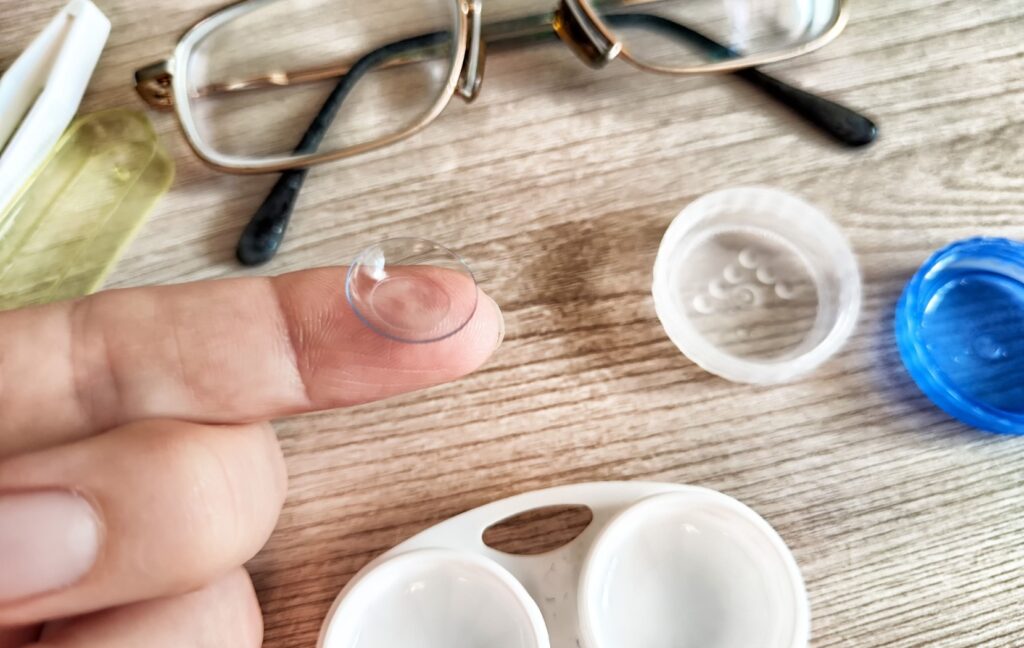Many people with dry eye syndrome wonder if they should give up contact lenses altogether. The burning, stinging, and constant discomfort can make wearing contacts feel unbearable. However, the good news is that having dry eye doesn’t mean you have to abandon contact lenses entirely.
Yes, you can wear contact lenses with dry eye. The key lies in choosing the right type of lenses, maintaining proper eye care habits, and working with your eye care professional to manage your symptoms effectively. With the right approach, you can enjoy clear vision and comfort simultaneously.
What Is Dry Eye?
Dry eye is a common condition that affects millions of people worldwide. This chronic condition occurs when your eyes are unable to produce sufficient tears or when the quality of the tears is poor. Your tear film consists of 3 essential layers, and problems with any of these layers can lead to dry eye symptoms.
There are 2 main types of dry eye disease:
- Aqueous dry eye: This type occurs when your tear glands don’t produce enough tear fluid to keep your eyes properly lubricated. Autoimmune disorders are often the underlying cause of this condition.
- Evaporative dry eye: The most common form of dry eye disease, this condition occurs when tears evaporate too quickly from the surface of your eye due to an unstable tear film.
What Does Dry Eye Feel Like?
Common symptoms of dry eye include:
- Burning or stinging sensations
- Blurry vision
- Excessive blinking
- Light sensitivity
- Eye redness
- Paradoxically, watery eyes
Several factors can contribute to the development of dry eye disease. Meibomian gland dysfunction (MGD) is the most common cause, occurring when the oil glands along your eyelids become clogged. Environmental factors, such as dry climates, prolonged screen time, and inadequate hydration, can also exacerbate symptoms. Additionally, overwearing contact lenses reduces oxygen supply to your cornea and disrupts your natural tear film.
How Contact Lenses Affect Dry Eye
Contact lenses can exacerbate dry eye symptoms in several ways. Since contacts sit directly on your eye’s surface, they can interfere with normal tear film distribution, leading to increased evaporation of your natural tears, making your eyes feel drier.
Specific issues include:
- Reduced oxygen supply: Contact lenses can limit the amount of oxygen reaching your cornea.
- Tear film disruption: Lenses can break up your tear film, causing faster evaporation.
- Mechanical irritation: The physical presence of the lens can cause additional discomfort.
Strategies for Wearing Contacts with Dry Eye

Despite these challenges, you can take several steps to minimize dry eye symptoms while continuing to wear contact lenses.
Choose the Right Type of Lenses
Consider switching to daily disposables! Daily contact lenses are often the best choice for people with dry eye. These lenses are typically thinner and more breathable than extended-wear options. Using a fresh lens daily means fewer protein deposits and debris that can cause irritation. Daily lenses also eliminate the need for cleaning solutions, reducing the risk of contamination.
Maintain Proper Eye Care
Opt for lubricating eye drops. Look for preservative-free artificial tears designed explicitly for contact lens wearers. These drops can penetrate through your lenses to provide relief directly to your eyes.
Follow proper hygiene. If you wear reusable lenses, clean them thoroughly and adhere to your replacement schedule. This reduces the risk of irritation and infection.
The Importance of Taking Breaks
Even with the right lenses and a proper care routine, taking regular breaks from contact lens wear is essential for those with dry eye. Removing your lenses periodically offers several benefits:
- Tear recovery: Your eyes get a chance to rehydrate naturally
- Reduced irritation: Breaks minimize mechanical irritation caused by lenses
- Overall eye health: Regular rest prevents long-term complications
Consider keeping a pair of up-to-date glasses as a backup for times when your eyes need a break from wearing contacts.
Treatment & Prevention Options
Dry eye is a chronic condition that requires ongoing management. While it cannot be cured entirely, symptoms can be effectively controlled with proper treatment.
Professional Treatments
Your eye care professional may recommend advanced therapies for severe dry eye symptoms, including:
- Radiofrequency therapy: Uses electromagnetic waves to generate heat and unclog blocked oil glands responsible for tear production.
- IPL therapy: Employs different wavelengths of pulsating light to target specific areas and stimulate tear production.
- LipiFlow treatment: Combines controlled heat with gentle pulsating pressure to help treat meibomian gland dysfunction.
At-Home Management
Several at-home strategies can help manage dry eye symptoms:
- Artificial tears: Use preservative-free drops compatible with contact lenses throughout the day as needed.
- Humidifier: Maintain optimal humidity levels in your home to prevent excessive dryness in the air.
- Limit screen time: Minimize digital device exposure and implement the 20-20-20 rule (every 20 minutes, look at something 20 feet away for 20 seconds).
- Warm compresses: Apply warm compresses to closed eyes and gently massage the area to unclog oil glands and stimulate tear production.
Take the Next Step Toward Comfortable Vision
Wearing contact lenses with dry eye is entirely manageable with proper care and treatment. Don’t let dry eye symptoms prevent you from enjoying the freedom and convenience that contact lenses provide. For personalized treatment options and expert guidance, connect with our team at The Vision Place to schedule a comprehensive dry eye evaluation. We’ll work with you to develop a customized plan that allows you to wear contacts comfortably while effectively managing your dry eye symptoms.


